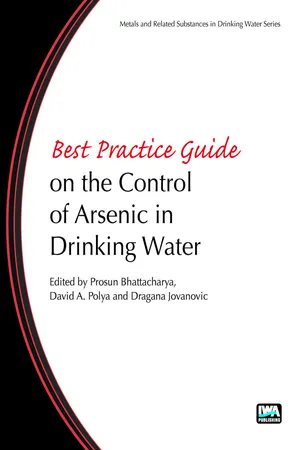
Best Practice Guide on the Control of Arsenic in Drinking Water
- 300 pages
- English
- ePUB (mobile friendly)
- Available on iOS & Android
Best Practice Guide on the Control of Arsenic in Drinking Water
About this book
Arsenic in drinking water derived from groundwater is arguably the biggest environmental chemical human health risk known at the present time, with well over 100,000,000 people around the world being exposed. Monitoring the hazard, assessing exposure and health risks and implementing effective remediation are therefore key tasks for organisations and individuals with responsibilities related to the supply of safe, clean drinking water.
Best Practice Guide on the Control of Arsenic in Drinking Water, covering aspects of hazard distribution, exposure, health impacts, biomonitoring and remediation, including social and economic issues, is therefore a very timely contribution to disseminating useful knowledge in this area. The volume contains 10 short reviews of key aspects of this issue, supplemented by a further 14 case studies, each of which focusses on a particular area or technological or other practice, and written by leading experts in the field. Detailed selective reference lists provide pointers to more detailed guidance on relevant practice.
The volume includes coverage of (i) arsenic hazard in groundwater and exposure routes to humans, including case studies in USA, SE Asia and UK; (ii) health impacts arising from exposure to arsenic in drinking water and biomonitoring approaches; (iii) developments in the nature of regulation of arsenic in drinking water; (iv) sampling and monitoring of arsenic, including novel methodologies; (v) approaches to remediation, particularly in the context of water safety planning, and including case studies from the USA, Italy, Poland and Bangladesh; and (vi) socio-economic aspects of remediation, including non-market valuation methods and local community engagement.
Frequently asked questions
- Essential is ideal for learners and professionals who enjoy exploring a wide range of subjects. Access the Essential Library with 800,000+ trusted titles and best-sellers across business, personal growth, and the humanities. Includes unlimited reading time and Standard Read Aloud voice.
- Complete: Perfect for advanced learners and researchers needing full, unrestricted access. Unlock 1.4M+ books across hundreds of subjects, including academic and specialized titles. The Complete Plan also includes advanced features like Premium Read Aloud and Research Assistant.
Please note we cannot support devices running on iOS 13 and Android 7 or earlier. Learn more about using the app.
Information

Table of contents
- Cover
- Half Title
- Title Page
- Copyright Page
- Contents
- About the Editors
- Authors
- Acknowledgements
- Acronyms
- Definitions
- About this Best Practice Guide
- Disclaimer
- Foreword
- Dedication
- Executive summary
- Chapter 1: Arsenic in drinking water: sources & human exposure
- Chapter 2: Public health effects of arsenic exposure
- Chapter 3: Health surveillance and biomonitoring
- Chapter 4: Regulatory aspects of arsenic in drinking water
- Chapter 5: Sampling and analysis for monitoring arsenic in drinking water
- Chapter 6: Selection of arsenic remediation strategies in the context of Water Safety Plans
- Chapter 7: Arsenic remediation of drinking water: an overview
- Chapter 8: Sustainable arsenic mitigation – from field trials to implementation for control of arsenic in drinking water supplies in Bangladesh
- Chapter 9: Community awareness and engagement for arsenic management
- Chapter 10: Valuing the damage of arsenic consumption: economic non-market valuation methods
- Chapter A1: Arsenic hazard and associated health risks: New England, USA aquifers
- Chapter A2: Geostatistical modelling of arsenic hazard in groundwater
- Chapter A3: Estimating the population exposed to arsenic from groundwater-sourced private drinking water supplies in Cornwall, UK
- Chapter A4: Hair arsenic as a reliable biomarker of exposure to arsenic in drinking water
- Chapter A5: Automated on-site arsenic monitoring
- Chapter A6: ARSOlux – the arsenic biosensor
- Chapter A7: Centralized arsenic removal from drinking water in the United States
- Chapter A8: Survey of real scale water treatment plants in Italy
- Chapter A9: Case studies on best practice in Italy
- Chapter A10: Remediation case study: drinking water treatment by AOCF to target <1 µg L−1 effluent arsenic concentration
- Chapter A11: Control of arsenic in the European Union: case studies from Poland
- Chapter A12: Arsenic removal from water by reverse osmosis technology
- Chapter A13: Case study: the social context of arsenic regulation and exposure in South East Hungary
- Chapter A14: Groundwater sampling, arsenic analysis and risk communication: Cambodia case study
- Author Index
- Subject Index